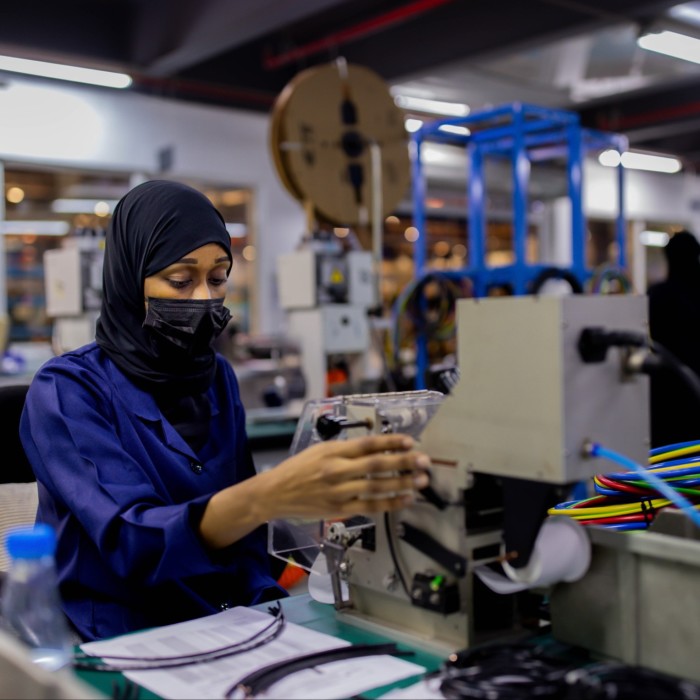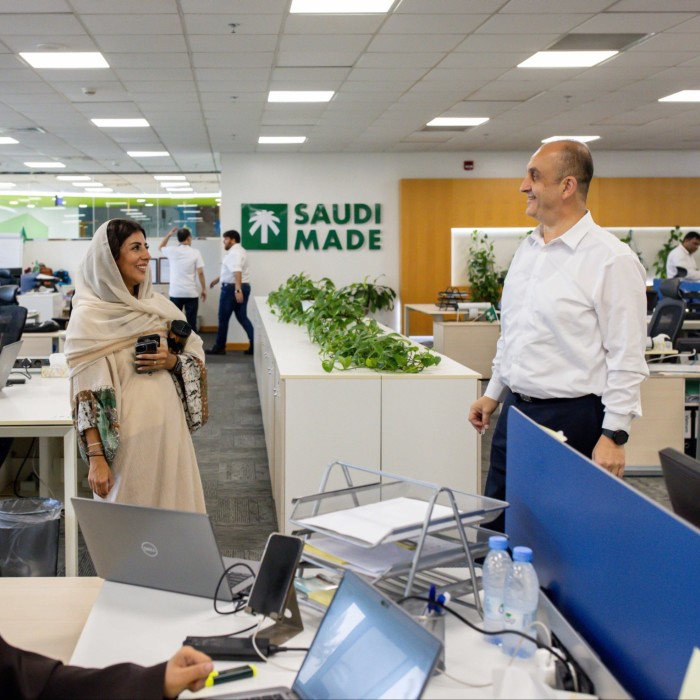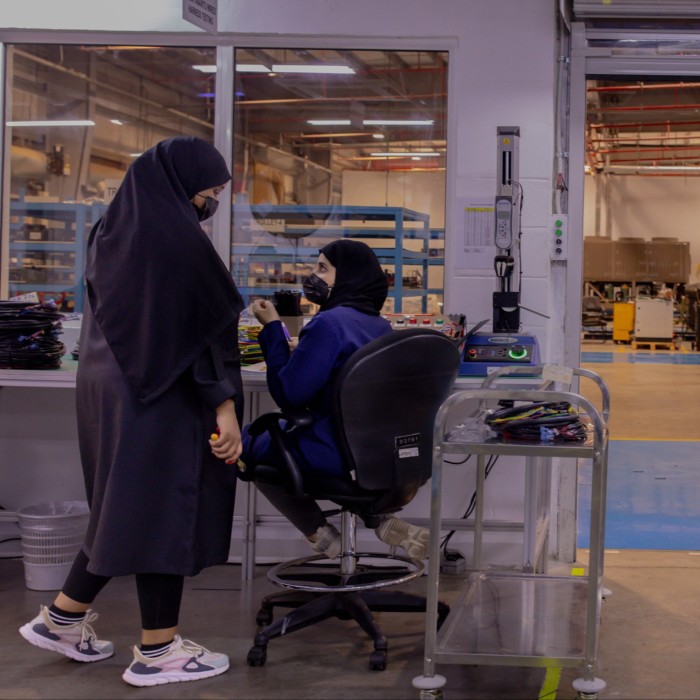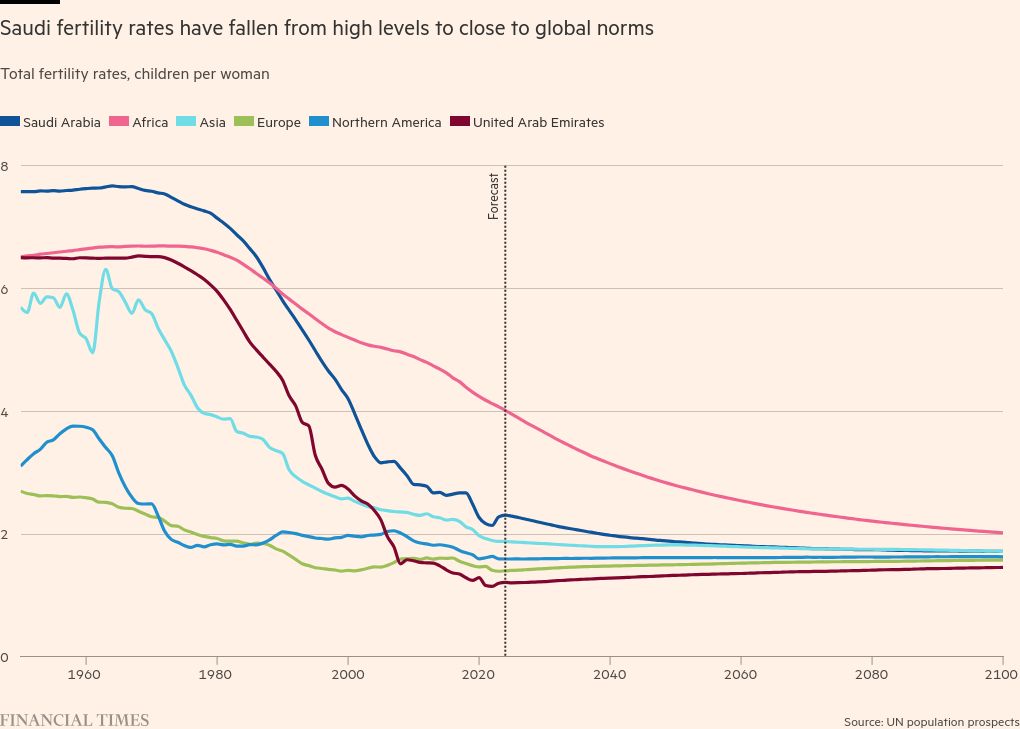
When Rawan al-Harbi graduated in 2017, she had expected to end up working in the female-dominated education sector. Instead, she found an opening at Johnson Controls Arabia, an air-conditioning plant in King Abdullah Economic City, 100km to the north of Jeddah.
“At the beginning it was a bit hard. It’s a far-out location and everything is new,” the 29-year-old said on the factory floor. “But I got used to it.”
Today she is one of more than a dozen Saudi women working in the electrical and control department, sitting on workbenches across the room from male colleagues.
As the men solder components, the women cut and crimp the colourful wires that go into rooftop units and chillers used to cool big buildings frazzled by the desert sun.
The scene would have been unthinkable a decade ago.
Many freedoms accorded to women elsewhere remain forbidden in Saudi Arabia. Women are still required to obtain the consent of their male guardian to get married in most cases, and it remains difficult for them to initiate divorce. Rights groups have also criticised the practice of men receiving a larger share of the proceeds of inheritances than women.
But Crown Prince Mohammed bin Salman’s push to diversify the economy and modernise society has made the female presence in many aspects of daily life increasingly common. That includes spaces such as factories, once exclusively the preserve of men.


With Saudi Arabia struggling to attract investment and launch new industries, a surge in female labour force participation has emerged as a bright spot.
General Authority for Statistics figures show the participation rate was 35.8 per cent in the second quarter, surpassing the 30 per cent goal years ahead of schedule. In 2015, the participation rate was just 16.4 per cent.
“You cannot ignore women’s contribution to the labour market,” said Abdullah Altimyat, chief executive of the privately owned Saudi Manpower Solutions. “We see in some areas of industry the quality of service added because now you have a wider pool of people competing to develop better services.”
The integration of Saudi women into the labour force beyond the education and healthcare sectors, where they have worked since the 1960s, was initially a slow process. Religious conservatives, worried about the westernisation of society, and business owners unwilling to accept government diktats served as bulwarks.
The first major change occurred a decade ago, when the government began to implement a policy passed in 2006 that allowed women to work in lingerie and cosmetics retailers. This expanded gradually to allow women to work in other customer-facing roles.
Initially, many businesses were reluctant to make changes to accommodate female workers. Women were still not allowed to drive and required permission from their fathers or husbands to work.
The labour ministry tried to sidestep these issues in 2017 by offering working women subsidies for Uber and other ride-hailing apps, as well as free training. But barriers remained high.


A landmark moment came in June 2018 when the kingdom finally lifted its ban on women driving, even though some female activists who fought the ban were jailed just weeks earlier.
Norah al-Zahrani, a business development specialist at TASC Outsourcing in Riyadh, said lifting the driving ban not only contributed to the social shift but boosted women’s confidence.
“[It put] women at ease in commuting to work and also made them feel independent and happy with [taking] the driving seat in their own lives,” she said.
This was followed by a series of measures to ease male guardianship rules, including a decision in 2019 to allow women above the age of 21 to travel abroad without their guardian’s permission.
The freedom that has come from work has created a younger generation of women who no longer see themselves as less capable than men.
“It is about both financial independence and self-fulfilment. A human being must feel productive,” said Seham al-Harbi, a female supervisor at the air-conditioning factory. “We now live at a time when it is normal that a girl is like a boy — if you work hard, you get rewarded.”
Nadia Malaika, chief human resources officer at SADAFCO, a dairy and food company, said: “I always tell my daughter: you don’t know how good you have it. People need to really appreciate the times that they’re living in, the opportunities that they have.”
Yet, while the increasing number of women in the workforce has been positive for the Saudi economy, the rapid change that came with it has raised questions about a shift in gender roles and sparked tension among more conservative elements of society.
Traditionally in Saudi Arabia, the man alone is expected to provide financial support. But many women are now earning as much, or even more, than their husbands. The issue of how much women should contribute to the household, if at all, remains unsettled.
“In the same way that you’re not seeing men roll up their sleeves and start helping with dinner, you’re not necessarily seeing women putting their money into a joint account for the family,” said Hanaa Almoaibed, a consulting fellow in the Middle East and north Africa programme at Chatham House.
“Until you see more men helping with the childcare and cooking, you’re probably not going to see more women contributing to the family finances.”

Financial independence may still be contributing to a rise in divorces over the past 15 years, along with a fall in the birth rate as more women prioritise career advancement over raising children.
“The divorce rates will continue to increase and the number of children per woman is probably going to continue to decline,” Almoaibed said, noting that many in society were uncomfortable with these changes.
Women are also largely absent from senior leadership positions in both the government and private sector. A recent study by the Institute of Public Administration, a government body, showed 96 per cent of top jobs in the government were held by men.
Saudi Arabia has named several female ambassadors in recent years, but there are still no women in the cabinet. But many women say the progress made so far should be celebrated and used as a springboard.
Najat Alsomali, head of human resources at Johnson Controls, recalled a time when attending meetings with men was fraught with difficulty.
“To be totally myself was a challenge, honestly speaking,” said Alsomali. “Now I don’t feel like that at all.”
Data visualisation by Valentina Romei